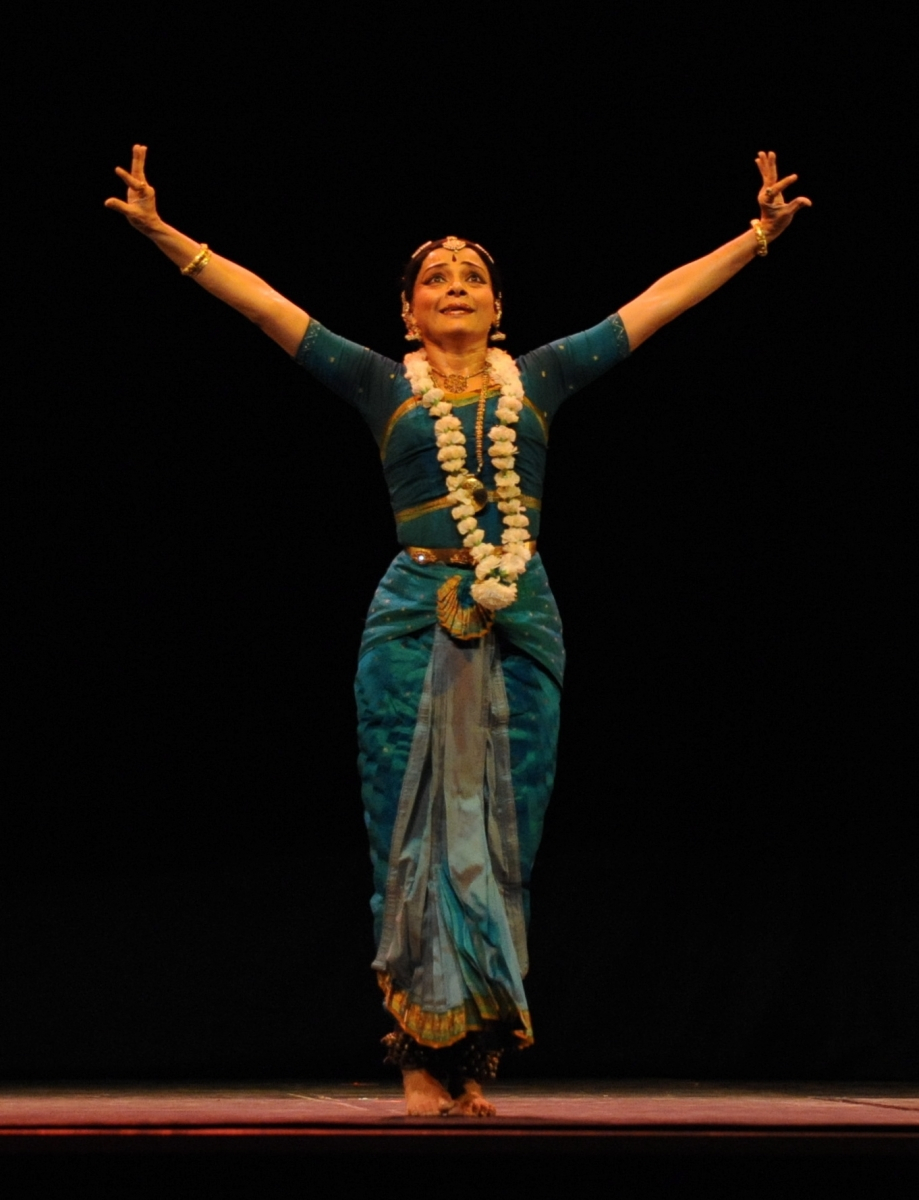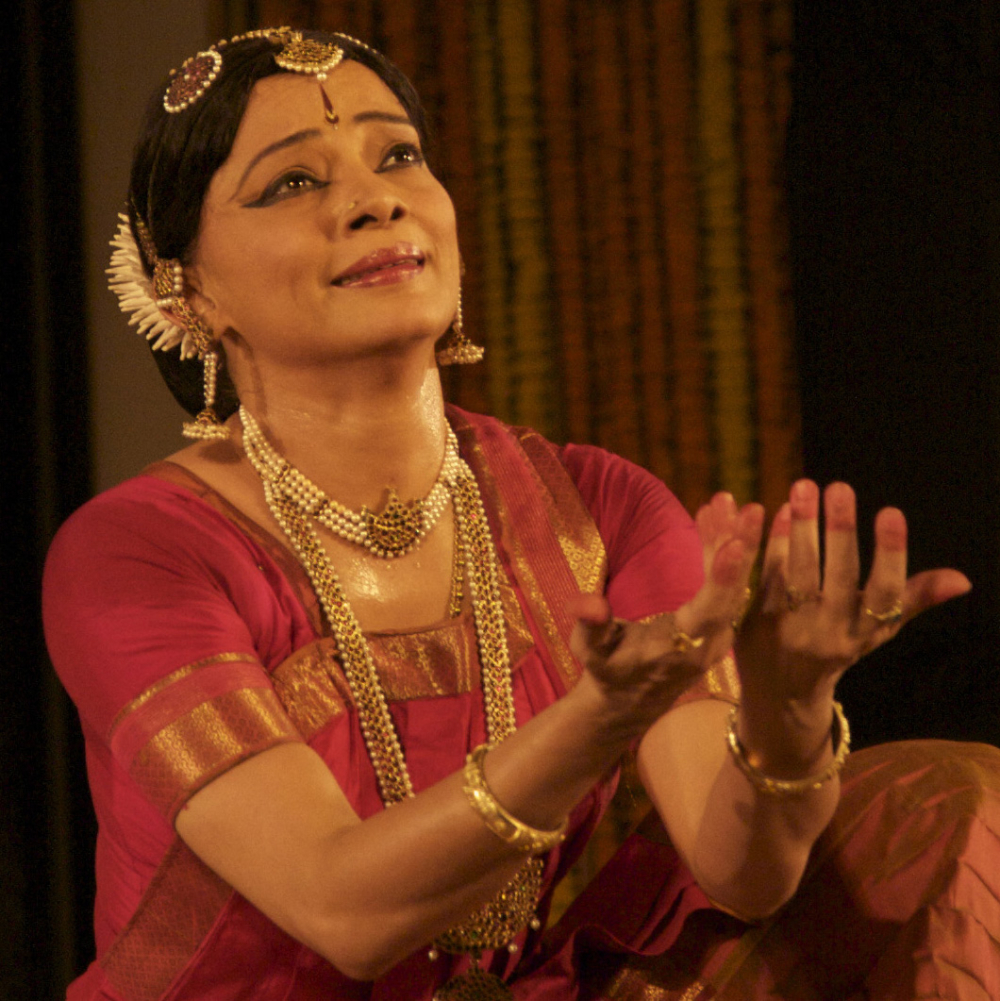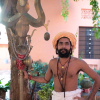This essay is the celebrated danseuse’s keen introspection into her study of the rasa theory and the understanding of it along with the application of its elements in her choreography. Written with artistic perception and subtlety, the prose liberally quotes from varied texts thus adding layers to an already rich narration. This essay exemplifies how practitioners of subcontinental classical dance forms such as Bharatanatyam still hew to the rules of rasa theory while exploring individual expressions, thus re-enacting Bharata’s ancient codifications for contemporary audiences.
Reading Ananda Coomaraswamy’s article on Rajput painting, a particular sentence made an indelible impression—I quote, ‘The holy land is the land of our own experience. All is in all and if beauty is not apparent to us in the well known, we shall not find it in things that are strange and far away’. This in a sense crystallised the Rasa theory for me, where the dancer-artist by intense envisioning of the moment, creates the sacred experience in the here and now. Envisioning in the moment the sacred, creating in the space around her the holy, communicating and sharing the personal sacred, the artist visualises the ‘holy land of our own experience’.
As I reflect on this, I wonder if the ‘moment’ of rasa experience is the dancer and the dance, the dancer as the dance, only the dancer or only the dance. The word rasa imperceptibly enters the world of the artist as she starts her dance journey. If the dancer is a seeker, the meaning grows significantly. As with any profound word, meaning, interpretation and understanding evolve with the individual’s maturity of mind. All through an artist’s life, the word rasa follows as a shadow, elusive yet distinct, with the meaning stretching and changing as the light of understanding falls on it.
To quote A.K. Ramanujan,
'In ‘traditional’ cultures like India, where context sensitivity rules and binds, the dream is to be free of context. So rasa in aesthetics, moksha in the ‘aims of life’, sannyasa in the life-stages, sphota in semantics, and bhakti in religion, define themselves against a background of inexorable contextuality.'
In the realm of feeling bhavas are private, contingent, context roused sentiments, vibhavas are determinant causes, anubhavas the consequent expressions. But rasa is generalized, it is an essence. In the field of meaning, the temporal sequence of letters and phonemes, the syntactic chain of words yields finally a sphota, an explosion, a meaning which is beyond sequence and time. In each of these, the pattern is the same; a necessary sequence in time with strict rules of phase and context ending in a free state.
The rasa sutra states, ‘vibhava, anubhava, vyabhicari samyogath rasa nishpatihi’ and Abhinava Gupta, the 13th century commentator on the Natya Sastra, has likened the experience of rasa to ‘brahmananda sahodara’. Simply put, the rasa experience is likened to the attainment of bliss and is a momentary transformation.
It is with this belief in rasa and the profound validity of the ‘moment’ that my art has evolved. This has been my search: to transcend the body even as one celebrates it.

Photo credit: Saibal Das
In search for the ‘moment’ there are many questions that arise in me. How does the artist make it her own and situate it in the site of her body? How can she make the body transcend itself? Can one command the moment to occur or does one prepare for it in anticipation? Can it be rehearsed? What is the state of mind when the ‘moment’ happens? Is rasa a moment of movement or stillness? And can this ‘moment’ be recalled? Many questions arise repeatedly filling the mind with possibilities. But above all, seeking rasa, is aligning of the self to savour a moment of intense experience. A release!
I remember an oft-quoted story, of the essential inter-relationship of the arts. The dialogue between King Vajra and Sage Markandeya in Vishnudharmottara Purana. King Vajra requests the sage to accept him as his disciple so he may learn the art of icon making for his worship. The sage in turn advises him to learn painting, as only then will he gain a grasp of image making. For this he has to learn dancing and to understand the realm of rhythm he must have a knowledge of instrumental music. And so it is that the king learns many arts before the art of iconography.
This creative dialogue between the arts gives artists the freedom of imagination, enabling their art to be inter-disciplinary. Sculpture, music, painting, temple architecture and dance incorporate elements of each other as is seen in the sacred geography of India. Plurality of the creative impulse was encouraged, giving artists the scope to be inventive. This vibrant approach enables agile thinking and a supple mind engaging the artist’s creative process in the vertical and the horizontal, thereby deepening the work in form and content.
For me as a classical dance choreographer, the aesthetics of form is vital. It concerns the movement of the body in space and holds true not only for nritta (pure dance) but also for abhinaya (expressive dance). At one level it is the grammar, technique and interpretation of the style, but at deeper levels it is the quality of dance energy that fills the membranes of the body. So, one is constantly and simultaneously working at several levels: the physical, intellectual, emotional and spiritual.
To quote Dr Kapila Vatsyayan,
'The quest of the classical Indian arts was a pursuit of absolute form, which would suggest through its flawlessness, the ultimate state of being and which would transcend the transitory, the chaotic, the subjective and the personal in man.'
Indian dance, like Indian poetry, music and sculpture, seeks to communicate universal, impersonal emotion, and, through the very medium of the human form, it transcends the physical plane.
As an artist I asked myself how does one transcend from the laukika to the alaukika, from the worldly to the other-worldly, the sacred? How does the artiste create this vision? Feel the presence? If one speaks of the body as patra (vessel) what does it contain? What part does the brain or mind play in it? These are some of the questions that arise within one on the journey of dance creation. A painter or sculptor works with an external medium. However, for the dancer her body is her medium. Through sadhana, a process of internalisation within her, she works to align the body and mind so that her being becomes a patra (vessel) which can contain the waters of ‘becoming’. One could best describe the rasa moment as one of ‘mindfulness’. When the being of the dancer is alert with an all- consuming intensity, a moment when thought doesn’t seem to move and feeling is all pervasive. For me the dancing body is the site—a site both sacred and temporal, lit up as it were, during performance.

Photo Credit: Brian Slater
Perhaps it is this intense ‘becoming’ that scholar Krishna Chaitanya mentions when Abhinava Gupta uses the word ‘Anukeertanam rather than Anukaranam’. To quote him, ‘art does not imitate the forms which are the end products of Nature’s activity but imitates that creative activity itself.’
There are two choreographies entitled ‘Darshan’ and ‘Raas’ which I explore in this article. They were inspired from different impulses: Chola bronze sculpture and Indian miniature painting. In each composition, I discovered that the energy and dance design are unique. ‘Darshan’ condenses the penetrating funnel of bhakti into the self, whereas ‘Raas’ celebrates the very same in an ecstatic outpouring.
As a thinking choreographer, I realised that each composition is distinct in sthayi bhava, movement vocabulary, spatial dynamics, development and design. The dance energies inhabiting the two choreographies originate in the empirical world but gaining momentum, push towards abandonment and release. Both compositions move inescapably towards the overflow of bhakti, moments involving a surrender of identity culminating in ecstasy…and rasa, a state of being which suggests suspended infinity.

Photo credit: Saibal Das
I was at the Smithsonian Institute, Washington to present a concert at the exhibition, ‘The Sensuous and the Sacred’. Walking around the museum I saw to my amazement, a small one-foot Chola bronze of Hanuman. The image was reverential, suggesting infinite bhakti. It moved me.
In viewing the works of the great bronze casters of the Chola period, I think one is essentially made aware of the concept of stillness and movement, sthiti-gati. A point of frozen movement infused with an energised equipoise. Perhaps it is this principle held within the bronzes that fills the images with prana (vital energy) giving them a living, enduring presence. And perhaps it is this prana that is invoked in the bronze in the prana pratishta ceremony. Sculpture and dance are greatly influenced by each other. Sculpture arrests dynamic movement and dance sculpts space. In a search for harmony and alignment, the Indian artist attempts to recreate the divine presence, through finite symbols of stone and metal, line and movement.
Dance and sculpture share a vital life force which resonates within the body of the icon as well as the body of the dancer. Two mediums, lit by the same energy, i.e., two patras (vessels) filled with the same energy. What binds sculptor and dancer together is then the intent, spiritual and emotional, that the artist pours into the making of the mould, to make it live. As each bronze made in the lost wax method is different from the other and no two bronzes are exactly alike, so is the making of each dance piece, fresh at every concert, recast and made anew. A rasika, a person who looks into the dance piece rather than looks at it will notice the nuanced changes and shifts in interpretation— a subtle gesture, a varying design, a different poetic emphasis.
The sculptor and dancer draw from inherited knowledge, traditional practice and individual imagination (pratibha). All this together with the tools of technique and the fire of intent create a new bronze, a new dance composition. Over the years as my personal style evolved I found myself wanting to touch the essence of an emotion, with my whole being. Ideas, clever interpretations and factual symbolism did not hold my attention. I lost interest in literal depictions and padartha (word for word interpretations) however well-formed they were. I found my style instead embracing the physicality of expression and hence becoming more evocative. This required a courageous diving into dance language. And through this rigorous engagement I found a defining language which spoke of ‘treeness’ rather than tree and ‘birdness’ rather than bird! My discovery of body intelligence together with mining the mind made me push the boundaries in movement vocabulary, emotional interpretation and dance design.
I believe when art is personalised with harmony and alignment, it becomes response rather than studied action, creation rather than rendering. The body is like a fine-tuned instrument alert and ever ready for the new to arise. In ‘Darshan’, becoming the character of Hanuman was a challenge. For days, I worked at the choreography yet I was unsatisfied. Somewhere I felt an incompleteness. Until one day I had the courage and freedom to actually feel the heaviness and length of Hanuman’s tail. When it became a part of my body language effortlessly, I knew I had made the ‘crossing’.
In ‘Darshan’, Hanuman enters with a patra pravesham which flows into the poetry of Saint Tulsidas (16th Century CE). The sollukattu is set in Ragam Malayamarutam and Adi Talam by B. Seetarama Sarma. Hanuman is excitable and playful and is seen ‘monkeying’ around in the forest on Rishya Parvata in the Kishkinda Kandam of the Ramayana. One sees at the outset a mischievous, curious, wonderstruck Hanuman. Everything delights him—be it the lotus pond, the heavy pollen filled flowers on the trees, or the young shoot that grows into the magnificent tree. Into this scene walk Rama and Lakshmana, after the abduction of Sita. Time stands still as Hanuman hears of Rama’s lineage. Gazing at Rama in adbhutam (wonder) and beatific adoration, Hanuman realises he has found his Lord. Falling at his feet, he surrenders in a mood of unconditional bhakti.
There were times when I danced ‘Darshan’, I experienced a resonance of such clarity that returning to the empirical world seemed futile. The ‘moment’ of rasa had pervaded me.

Photo credit: Narendra Dangiya
To enter the world of painting, it is appropriate to start with a quote of Ananda Coomaraswamy,
'Rajput art creates a magic world where all men are heroic, all women are beautiful and passionate and shy, beasts both wild and tame are the friends of man, and trees and flowers are conscious of the footsteps of the Bridegroom as he passes by. This magic world is not unreal or fanciful, but a world of imagination and eternity, visible to all who see with the transfiguring eyes of love. This faith, I believe is what has inspired artists through the centuries to sing, dance, sculpt, paint and create their world of dreams. Without an intense and complete internalization, art and its envisioning cannot happen.'
I think, all artists share the moment of the birth of creation…before the painting emerges, before the dance actualises, before the sculpture manifests, before the voice strikes the note…a moment when the artist is all alone, pausing in silence gathering inwards the discipline and freedom their art form grants them. Choreographing the dance of ‘Raas’ required me to envision colour, movement, multiplicity, and epiphany.
Relating dance to painting I think they share a few concepts like space, etching, colour and details. The canvas of space is empty for both the painter and the dancer till the depiction begins. Both artists wait, poised for the drawing to begin. As the painter sketches with the deft strokes of the brush, the dancer too draws with her body, with line and movement, strength and grace, stylisation and naturalness.
The world of colour fills paintings with a life force, imbuing it with meaning, aesthetics and more. Translated in dance it would correspond to the rich, diverse range of emotions. As the painter colours the painting giving it a life force, the dancer using abhinaya evokes on stage an energized presence. Intensity of colour and intensity of emotion draw one’s attention. Just as in painting, colour infuses the body of the character, in dancing emotion infuses the body of the dancer. The grace and aesthetics of a painting are further affected with the subtle details the painter brings to his craft. The dancer adds gamakas (subtle movements) in emotion and gesture, embellishing the moment.
My choreography of ‘Raas’ has lyrics from Srimad Bhagavatam (10th Century CE), set to music in Ragamalika by Sri B. Seetarama Sarma. Drawing inspiration from several miniature paintings I celebrate the mandala of the circle. The circle is emphasized in the choreography and repeats itself as a hypnotic diagram. From the emotional churn of love, it becomes the dance of gay abandon in the woods and finally, the dance of ‘Raas’ itself.
Sharad is the season of autumn, when the skies have been washed clear by the rains and moonlight bathes the earth. The flute of Krishna beckons. Women follow in abandon as Krishna leads the way into the deep dark woods. And in a clearing by the light of the moon they dance the Raas. They dance in ecstasy all night. They dance together with Krishna in the centre. They dance with Krishna simultaneously dancing with each maiden, fulfilling her desire.
In my choreography of ‘Raas’, the emotional content is intense and richly coloured. The dance moves from the everyday to the magical, from the known to the unknown. The mood starts with sringaram as the gopis (young maidens) are bewitched by Krishna’s flute and inexorably move into the realms of sringara bhakti. As the mood builds to ecstasy, the music structure moves beyond the defined. As the narrative builds up towards ecstasy, music and dance improvisation overlap taking one towards the mesmerising world of rasa, essence.
The gong stands silent, waiting
The striker is moved on the surface in repeating circles,
The sound and performance resound
Finally the resonance within,
The resonance within.
*************************************













